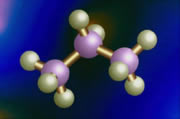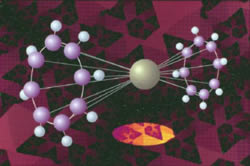|
The movie "Terminator 3" told the tale of the rise of the self-aware machines, and they turned out not to be very nice machines. But in all three of the Terminator movies, we could at least see the machines that threatened humanity, even if they were occasionally disguised as a police officer or a tiled floor.
A new class of super-small machine technologies is gaining speed. Nanomachines, also called nanobots, along with nanomaterials, their non-machiney counterparts, are on the rise. With nano-machines and nano-materials, we're talking about sizes on the atomic level—so small that even a six-million dollar eyeball would not be able to zoom in to see them. The goal of the scientists and corporations pursuing these technologies is to apply them in a wide variety of laboratory and real-world scenarios, doing everything from enhancing chemical reactions to storing hydrogen efficiently to cleaning up environmental toxins.
 Nano-techniques take advantage of the unique physical and chemical behavior of materials at near-atomic sizes. But the behaviors are not yet completely predictable, especially in terms of their long-term effects; the behaviors of nano-machines may not necessarily always be controllable; and nano-everything has the potential to cause environmental and health problems because of the extremely small sizes and unusual behaviors.
Nano-techniques take advantage of the unique physical and chemical behavior of materials at near-atomic sizes. But the behaviors are not yet completely predictable, especially in terms of their long-term effects; the behaviors of nano-machines may not necessarily always be controllable; and nano-everything has the potential to cause environmental and health problems because of the extremely small sizes and unusual behaviors.
Animal experiments have shown that nanoparticles and nanomaterials can have extremely damaging effects on the lungs. Remember that nanoparticles present in the air would be easily inhaled—wearing a standard dust mask would be ineffective at protecting a person from them.
Other experiments have observed migration of nanoparticles within the bodies of lab animals. This is one reason that some researchers hope to use nanobots to deliver targeted drugs in the human body—once the migratory behavior is better understood. Beyond the question of whether they will be able to accomplish this, here are some of the other questions we should make sure scientists are answering:
- Can the nanobots deliver the drug with acceptable accuracy? What "collateral damage" could the nanobots do to the body while delivering the drug?
- What happens to nanoparticles or nanobots after they've accomplished their mission? Are they excreted, and if so, what is their activity in the environment? What consequences could that have?
Another envisioned application of nanotechnologies is longer-lasting tires that incorporate super-tough nanomaterials called aerogels. But what happens as the tires wear down and the aerogel nanoparticles wash off the roads and into the environment? Maybe nothing, but since they're so small, could they be ingested by the tiny life forms that are the building-blocks of the food chain and the web of life? What would be the impact?
Targeted drugs and aerogel tires are just two classes of nano-products. Some nano-products are already in use, and corporate scientists are busy cooking up all sorts ways this technology can be applied. They are also thinking about how to do it safely, but safety considerations appear to be quite secondary to corporations' effors to market profitable products as quickly as possible.
 Nanoscale technology, like nuclear technology and genetic engineering, operate at the most fundamental levels of the physical and living worlds.
Nanoscale technology, like nuclear technology and genetic engineering, operate at the most fundamental levels of the physical and living worlds.
So far, we've been able to avoid destroying ourselves with nuclear weapons or power plant meltdowns. But nuclear gets special treatment: Nuclear weapons are closely held by those that have them, nuclear power plants operate according to relatively strict safety protocols, and spent nuclear fuel gets special handling and care.
The products of genetic engineering (GE) have been much less tightly regulated, and in areas where GE crops have been grown—even when strict controls have been in place—material from GE plants have escaped their domain and genetically contaminated non-GE plants. Even as we come to recognize the negative impact genetic engineering can have on non-GE species and strains, it is still a poorly regulated industry. Indeed, rather than tightening regulations, the US government is doing the bidding of large agribusiness interests by actively petitioning other governments to undo the precautions they have taken on GE safety issues that currently prevent US GE products from entering the other countries' markets.
 The point of all this is not to label nanotechnology as an emerging evil that should be stopped. There are some promising aspects to nanotechnology and they should be explored, but in tightly controlled environments. The more potent a technology, the tighter the research protocols we should require and the more years of study we should insist upon before permitting commercialization and release into the real world. That's not what nanotech companies or their investors want to hear, but it's the only responsible approach.
The point of all this is not to label nanotechnology as an emerging evil that should be stopped. There are some promising aspects to nanotechnology and they should be explored, but in tightly controlled environments. The more potent a technology, the tighter the research protocols we should require and the more years of study we should insist upon before permitting commercialization and release into the real world. That's not what nanotech companies or their investors want to hear, but it's the only responsible approach.
Unfortunately, government regulators are well behind the power curve on this issue. Though they are commissioning studies and developing policies, they do not yet seem to be in a position to do a proper job of protecting us. It's not obvious that, in the end, they will be able to do any better a job at controlling nanotechnology than they have at governing genetic engineering. Letting your congressional representative know that you're concerned about this emerging issue could help spur action.
Now, if you'll excuse me, there's a noise in the kitchen—like a gazillion nano-cookies are trying to escape from their box and invade my mouth.
|


